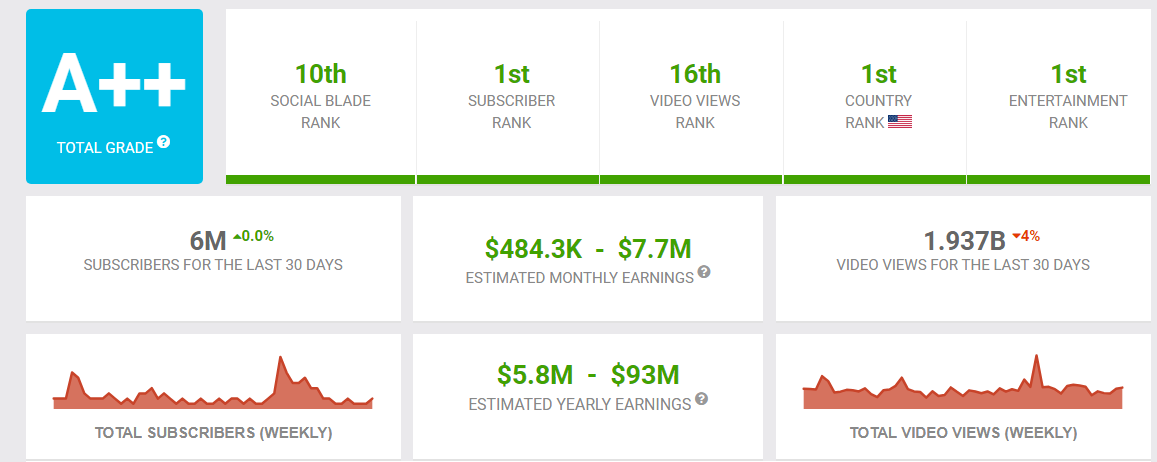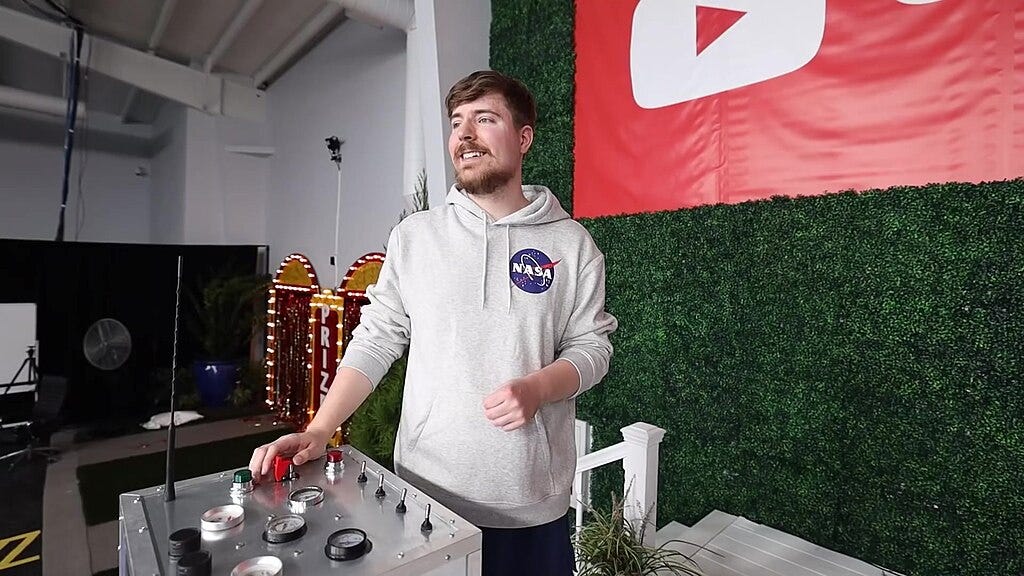📺 MrBeast's Media Business Secrets
MrBeast's onboarding docs and reverse engineering a media megasuccess story: Context Collapse #312
In this issue: What MrBeast does, how he does it and why you should pay attention to it even if you’ve never watched a MrBeast video.
MrBeast, a YouTube video creator in his twenties better known as Jimmy Donaldson before becoming a global megastar, is a media success story.
Donaldson and his production team make viral videos that dominate YouTube. A large part of his success was backing up stunt videos like 7 Days Stranded In A Cave and Last To Take Hand Off Lamborghini, Keeps It with a content production and business management approach that scaled his brand over and over again.
An internal onboarding document from MrBeast’s production company recently leaked and made its way across Twitter and Threads. For instance, check out this Twitter thread from entrepreneur Pat Walls:
There’s a lot in here that isn’t a surprise. His production company emphasizes long work hours and putting work first in a way that sounds familiar to anyone who has worked in high-pressure industries such as gaming design, film production, advertising or journalism.
Furthermore, the MrBeast model emphasizes doing stuff at rapid speed that would paralyze a mid-size or large company.
But there’s a lot more here that was unexpected and useful for anyone working in the communications or media world.
More after the jump. First, a word from our sponsor!
Need white paper, LinkedIn, YouTube, trade show, experiential or ghostwriting help?
I have limited client availability this autumn 2024 + would love to work with your agency or in-house team. Learn more:
Lesson 1: MrBeast Wants To Make One Movie A Week
Traditional television shows take their time making episodes. The only exceptions are daily or weekly shows whose content value expires almost immediately. You want to see today’s Today Show, not yesterday’s. A SportsCenter episode from last week is nice, but it’s not something you want to watch.
MrBeast’s team emphasizes speed and agility in content production. One quote stuck out to me:
“Your goal here is to make the best YOUTUBE videos possible. That’s the number one goal of this production company. It’s not to make the best produced videos. Not to make the funniest videos. Not to make the best looking videos. Not the highest quality videos.. It’s to make the best YOUTUBE videos possible. Everything we want will come if we strive for that. Sounds obvious but after 6 months in the weeds a lot of people tend to forget what we are actually trying to achieve here.”
Furthermore, MrBeast urges his team to make content that looks good for YouTube, and to ignore traditional television aesthetics. Again, the doing things quickly and getting things done thing:
“Let’s say you’re in production and a video you’re assigned to is put up 45 days out. A lot of things need to happen before you can start working on it. The big things would probably be you need a thumbnail sketch and creative on your team to write the video. DO NOT just go to them and say “I need creative, let me know when it’s done” and “I need a thumbnail, let me know when it’s done”. This is what most people do and it’s one of the reasons why we fail so much. I want you to look them in the eyes and tell them they are the bottleneck and take it a step further and explain why they are the bottleneck so you both are on the same page.”
Blunt. But it gets stuff done.
Lesson 2: Data, Data, Data

Netflix and Hulu both have cultural DNA—the way shows are commissioned, the way original content is made, the way successes are evaluated—that they inherited from the old worlds of cable and broadcast TV.
YouTube is a different beast. This is something MrBeast and his production company understand very well.
In the world of YouTube, success is less about making a $15 million episode of The Mandalorian than about understanding viewer technology and how it translates into the way individual people stare at the screen.
Team MrBeast uses three key metrics to gauge the success of videos: Click-Through Rate (CTR), Average View Duration (AVD), and Average View Percentage (AVP).
Click-Through Rate (CTR): How many people actually click on a video after seeing its thumbnail or title. If the thumbnail and title aren’t attention-grabbing, the video will sink to the bottom of the content sea. Higher CTR = more viewers, more eyeballs, more chance to grab attention.
Average View Duration (AVD): Average time viewers spend watching the video. The longer people watch, the better. YouTube listings and recommendations favor videos with high AVD; high AVD signals to YouTube’s algorithm that the content is worth promoting to more viewers.
Average View Percentage (AVP): How much of the total video the average viewer watched. Videos with high AVP count are more likely to go viral.
This all gets back to something I tell my own clients all the time: Metrics matter! And not silly nonsense metrics you pull out of a hat to make executives happy. The metrics that matter are the real, solid metrics about who’s looking at your content, where you gain or lose interest, and how content consumption is generating (or not generating) revenue.
This remains the same whether you are talking about entertainment, journalism, public relations, marketing, advertising, whatever. It is all the same.
More tips below! But first…
Lesson 3: Consultants As “Cheat Codes”
I’m a consultant, so I’m biased here. With that said, MrBeast and his team are on to something important: Consultants = cheat codes.
Consultants and contractors are tools that companies—including PR, marketing, advertising, and media firms—can and should use to solve specific and complex problems quickly.
Some specific examples MrBeast gives for using consultants are:
Helping make the world’s largest slice of cake
Growing a YouTube channel
Making a giant wooden stand for the world’s largest water balloon
Your team is overwhelmed? Hire a consultant to fix the biggest time-drain problem. Your team doesn’t have expertise? Hire a consultant who knows how to get something done. Organizational politics making things difficult? Hire a consultant who can work around the blocks.
Consultants, consultants, consultants.
Lesson 4: Creativity and Storytelling Over Budget
Some MrBeast videos are very expensive to make. However, the brand emphasis is on creativity and storytelling instead of throwing money at the wall.
One example from the MrBeast onboarding doc is where his team substituted a year’s supply of Doritos for a cash prize in one video:
People always assume money is the answer and if we just spend more money we can give Jimmy what he wants. Which is wrong, creativity is the answer. Here is an example I use all the time with our gaming team. They love to give away money every video. But. Which sounds cooler to you as a prize for a gaming video. $20,000 or a year’s supply of doritos? To me doritos is so much funnier and I think our audience would find it fucken hilarious.
So lets say we define a year’s supply of doritos by 5 packs of doritos a day for 365 days. That’s 1,825 packs of doritos and a quick google search shows you can buy a pack of doritos for less than a dollar but we can round up and just say a dollar per a pack of doritos. Our prize for the video just went from $20,000 down to $1,825 because we didn’t just throw money at the problem and we used creativity.
Or, as the doc puts it, "Creativity saves money. Every dollar we save allows me to give you guys more stability and hire more people to make your life easier."
A similar philosophy applies to the storytelling in the video themselves. Simple narratives in stunt or competition episodes keep audiences engaged.
Most MrBeast videos use clear narrative tools like “last-to-leave” challenges or competitions with progressively increasing stakes.
These are tools that anyone making content can and should use.
Takeaways
If MrBeast’s team had to have any documents leaked, their onboarding document is the one they would have wanted leaked. It shows a high-pressure but high-results workplace that figured out their own workflow that generated success in a very, very high-pressure industry.
Here’s the thing: No one has to work as a professional YouTuber, or making movies, television shows, video games, commercials, newspaper articles, podcasts, radio shows, TV sports broadcasts, or any of it. There are about 15,000 other industries that provide far better pay, benefits, work-life balance, and chances for advancement.
But if you want to give it your all to create something that matters to people, the MrBeast guide gives a pretty good overview of what you can add to your own mix.
I just said my piece. How about yours? Let us know in the comments.







